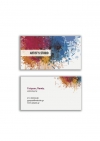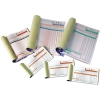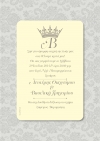-
Πότε θα είναι έτοιμη η παραγγελία μου;Από την στιγμή που συμφωνήσουμε στο τελικό έντυπο (στήσιμο μακέτας, διορθώσεις), η παραγγελία σας θα εκτελεστεί εντός 2-3 εργάσιμων ημερών.
-
Σε ποια μορφή να στείλω τη μακέτα μου;Το αρχείο πρέπει να σταλθεί σε οποιοδήποτε προγραμμα της Adobe (PDF, Photoshop, Illustrator) και εαν επιθημείτε επεξεργασία αυτού πρέπει να είναι "ανοιχτό".
-
Ποιες είναι οι συνηθισμένες διαστάσεις χαρτιού;
Α0 118.9 cm x 84.1 cm A1 84.1 cm x 59.4 cm A2 59.4 cm x 42 cm A3 42 cm X 29.7 cm A4 29.7 cm x 21 cm A5 21 cm x 14.8 cm A6 14.8 cm x 10.5 cm Φάκελοι αλληλογραφίας 11 cm x 23 cm Φάκελοι Α4 29.7cm x 21 cm Επαγγελματικές Κάρτες 8.5 cm x 5.5 cm
-
GUIDELINES
-
What does GSM mean? Which GSM or paperweight is right for?The term GSM is far from explanatory but you can guarantee that it will come up when talking to any printer worth his or her salt. This neat little article aims to explain the exact meaning of GSM. What does GSM mean and what does it mean for your printing?
GSM is an acronym standing for ‘Grams per Square Meter’. Quite simply, it allows print buyers and print suppliers to know exactly about the quality of paper that is being ordered. The higher the GSM number, the heavier the paper. If you’re buying print then make sure you know what you’re talking about. Being specific about the GSM you’re after can make all the difference and you’re likely to be taken more seriously by a printer if you ask for a specific GSM rather than just asking for thick or thin paper.
It’s worth noting that there are industry trends when it comes to GSM. If you are looking round a large number of print suppliers, such as StuPrint.com, you will notice that certain paper thicknesses will keep on popping up. Although any GSM is available, you’ll most commonly find: 55gsm, 90gsm, 100gsm, 120gsm, 140gsm, 210gsm, 250gsm, 300gsm, 350gsm and 400gsm.
GSM in practice: what paper thickness can you expect?
What paper thickness do different GSMs represent in real life? As an online company we are aware that selecting a paper weight without touching and feeling the paper can be a bit daunting. If you’re not in a rush for your print then please contact us to show you the whole range of paper stocks available. If you’re in a bit of a rush then let us translate these seemingly arbitrary numbers into commonly occurring paper you will have bumped into before now:
35gsm to 55gsm: This is very thin paper indeed. Most newspapers will commonly be printed on this paper thickness.
90gsm to 100gsm: This is the weight of most household printer paper. The stuff you might pick up in packs of 500 sheets at the office depot.
115gsm to 150gsm: This GSM range covers the paper thickness of most posters you’re likely to find on pub walls etc. Paper with this GSM is sturdy enough to withstand a bit of wear and tear. Its also the thickness of low-cost flyers you might have had posted through your front door by minicab companies and the like.
200gsm to 300gsm: Moving onto premium flyers now. This paper stock range is approaching card but will still have a bit of a bend when held with two fingers. Think of the magazine covers you see on the racks at newsagents.
350gsm to 400gsm: This GSM is essentially card. It will stand up under its own weight and is most commonly associated with premium flyers and business cards. As well, it is likely to be the stock that high-quality invitations are printed on.
-
What is Digital Printing and what is Lithographic Printing?
These two terms relate to the two main printing techniques/processes used in the print industry. They both deliver near enough the same product but they simply go about it in different ways. Digital printing takes digital information in the form of design files (PDFs, JPEGs, PNGs etc), converts that design into a print map then lays ink directly onto the paper. Commercial digital printing is essentially the same fundamental technique as the process used by your domestic DeskJet printer...commercial printers just do it to a higher standard!
Lithographic printing is a completely different method of printing. The digital design you send into your printer is actually engraved onto a metal plate. That plate is then covered in ink and rolled onto paper during the print process leaving a near perfect replication of your design. Modern lithographic printers are fundamentally very simple but very technologically advanced in practice. A decent litho printer is likely to set you back millions of pounds, not including the constant upkeep and other running costs.
Why do you need two different printing techniques is the results are essentially the same? Well as far as you, the customer is concerned it comes down to price. Digital printing has virtually no setup costs. Lithographic printing on the other hand has very large setup cost because of the engraved metal plates we mentioned above. So if you were going flyers it would be substantially more cost effective to use digital printing because of the reduced setup costs. However, digital printing is a more expensive print process in unit terms i.e. each individual, flyer, poster, leaflet etc. So when it come to doing print runs of 1000 copies plus, the setup cost starts to pay for itself and litho printing becomes substantially cheaper.
It’s worth noting that Lithographic printing is a far slower process than digital printing, mainly because of the plate engraving required. SELLA PRINTS offers a 4-5 working day turnaround on our lithographic printing and a 1-2 working day turnaround on our digital printing (standard delivery tiers).
FAQs
Offers
-
 1000 κάρτες
1000 κάρτες
Χαρτί velvet 300gr
1 όψη
Έγχρωμες
Ματ πλαστικοποίησηΜΟΝΟ 45 ευρώ!more... -
more...

-
 1000 stickers
1000 stickers
6 x 9 cm. (rectangular shape)
Gloss or mat paper
Color PrintONLY ?49more... -
 10 A4 Invoice Pads / NCR Business FormsWith the contact details of your companyTriple paper50 pages (each color)Worldwide Delivery
10 A4 Invoice Pads / NCR Business FormsWith the contact details of your companyTriple paper50 pages (each color)Worldwide Delivery
ONLY ?39.99more... -
 ?0.90more...
?0.90more...